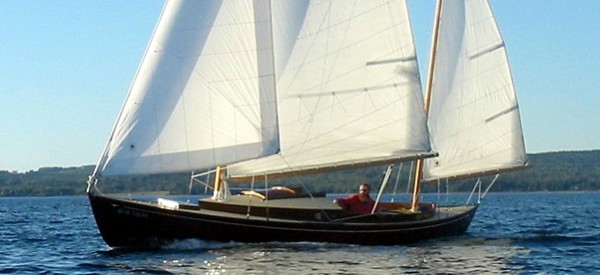The easy answer: So that when you wake up in the morning, sun streaming through a port light, you can admire the beautiful structure – the deck beams, sheer clamp, frames and ceiling – each with a purpose, perfectly sized to it’s requirements, made from the same woods that served the pharaohs, the same metals that the Greeks used for statues of the gods.

Some would have you believe that a plank-on-frame boat is an anachronism in today’s world – if you want a new wooden boat, better get yourself one made of tiny slivers stuck together with petrochemicals. Why have a traditionally buit boat? For the same reason that you might prefer to eat at a beautiful mahogany dining table instead of one covered with Formica. Or hand-write a note at a heirloom cherry desk instead of a mass-produced particleboard affair. Anachronisms perhaps, but in this world of accelerating change, traditional objects can help ground us, help us remember that there is more to humanity than the latest thing.
. . . sign up to the right to get immediate access to this full post,
plus you'll get 10 of our best videos for free.
Get Free Videos& Learn More Join Now!!for Full Access Members Sign In


David Mowen says:
For me, there is just no small boat better than the Swamscot Dory-Skiff. Mine is a small 12 or so foot long, so I can hoist it up on deck of White Wing if necessary. Before this skiff we had a White Hall as a tender, whose stern would suck down to the point that she’d break one lanyard after another when towed, and who knows how many knots she’d take of our progress. This handy Swamscott skiff has a center board, and who says these boats can’t sail to windward? And as to difficulty towing – – – she was being towed down-wind South of Block island, in quite a following sea (after one of those off-shore fall huricanes in ’88 or ’89) and heading for Nantucket’s Opera House via Woods Hole – – -and this skiff is passing us on both sides till we clamped a board on her transom to put on some brakes.
She was taken of the lines of a George Chaisson boat made for the the mother of one of the students at the Bath Apprentice shop. A guy North of Boston built her for me. She’s going to be a long time family pass-on-down. The workmanship is immaculate! I have his name for anyone interested.
George Chaisson
steven steele says:
That was well written
Charles Jackson says:
The ‘big’ picture is coming along nicely .
Charles Zimmermann says:
Very well written. A traditional wooden boat requires a lot of attention, and if some part of the wood needs fixing then you must fix it right away and not allow the damage to spread. However once you have the boat in top condition and you have figured out what’s needed to keep it in excellent condition, the boat acquires a timeless quality that is formidable. You look in the mirror and notice that you are getting older, but the boat is not getting older – in fact it seems to be perfectly content to keep sailing for another 100 years. This is not true of Fiberglas – we simply don’t know what a 150 year old Fiberglas boat looks like, nor do we know who would want it.
Alec Brainerd says:
Wow Doug, I’ve been waiting for someone to write this for years! Well done!
Benjamin Mendlowitz says:
Doug, Beautifully said!